
Nicole West with her DIY tattoo kit, and her first stick and poke tattoo
While most people get their tattoos in a professional tattoo parlor, others like to do it themselves. Tragically, some of them learn to from Youtube.
One how-to video, made by a high school senior, starts with her listing her materials: artist’s ink, thread, paper towels, and a sewing needle stuck to a pencil. In a four-minute fast-forwarded sequence, she repeatedly inks the needle, stabs it into her skin, and wipes off the blood and excess ink. In the end, she’s permanently scrawled the letters “CA” on the side of her middle finger. It looks like she drew it on in math class with a fine-tipped black sharpie.
Welcome to the questionable and increasingly fashionable world of “stick and poke” tattooing — that is, tattooing without a machine, and usually without any training.
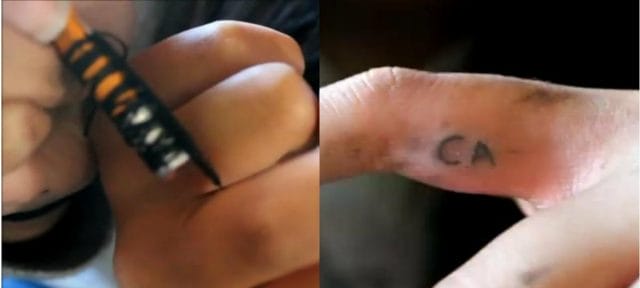
Stick and poke tutorial on Youtube

Stick and pokes on Pinterest
Instagram, Pinterest and Tumblr abound with photos of these designs. This, Style.com says, is the “new septum piercing.”
Unfortunately, as school teacher Nicole West notes, the stick and poke process is often pretty janky: involving toxic materials (like pen ink), unhygienic practices (like re-using sewing needles “sterilized” with a lighter), and huge health risks (like infections and AIDS). While others have preached stick and poke abstinence, West has built a controversial and profitable business around making home tattooing as safe as it can possibly be.
DIY Tattoos for the Squeamish
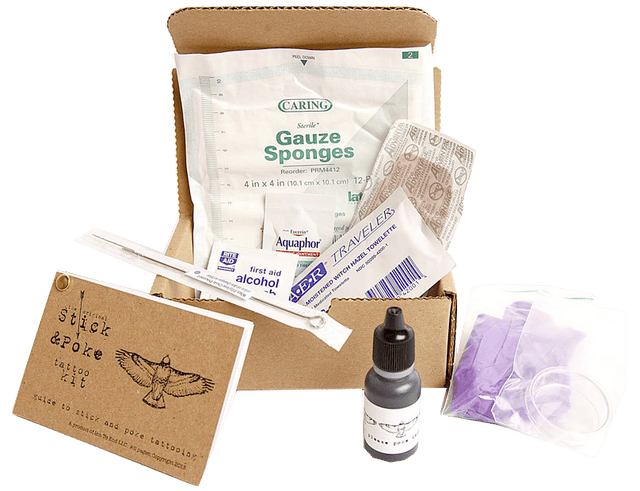
Nicole West’s Stick and Poke tattoo kit
As with many trends, it seems California was ahead of the curve. Nicole West went to her first stick and poke party in Oakland, a city to the east of San Francisco, back in 2009. There, a friend tattooed a simple circle on West’s forearm. West squirmed while she did it, and not just because someone was sticking her with a needle.
“I started thinking: Well what’s in this ink, and how are you sterilizing this needle that you’re using?” she tells us. “I’m a biology teacher,” she adds, in explanation.
But, West says that she still liked her first stick and poke experience much more than her first experience with a professional tattoo parlor: She had accompanied her crush to a shop in North Beach, and ended up getting tattooed herself, even though she could tell just from the images on the wall that it wasn’t really “her scene.”
“Dragons, Japanese characters that say ‘Courage’, naked women — I don’t belong that kind of environment,” West says. “I go into that kind of place with the mentality, ‘I’m going in to get out with this thing, but the experience is not something that I’ll enjoy.’”
At her first stick and poke party, West says she discovered the comfort of a friend’s home and the warmth of a friend’s touch create a socially and psychologically “safe environment” in which to modify her body.
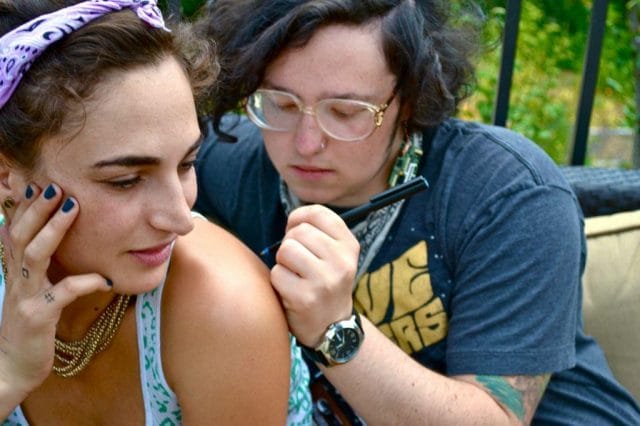
West’s friends prototyping a new design
The problem was that the materials and practices used for DIY tattooing still weren’t necessarily medically safe, even among her open-minded, politically active, educated and adult friends. For starters, some blood borne pathogens can survive common home-sterilization techniques, including bleach, boiling, and hydrogen peroxide. And many stick and poke tattooers wrap their needles in thread to hold ink near the tip — usually sewing thread, which is rarely sterile because it’s so difficult to sterilize. What’s more, the ink itself might be contaminated, either with bacteria (especially if the bottle isn’t newly opened) or with harmful chemicals if it isn’t proper tattoo ink (although even tattoo ink is not FDA regulated.)
West says that even though she saw the problem immediately, it was only years later that she realized she could actually do something to solve it.
“I was travelling in Malaysia and I met this Spanish couple who designed websites to support themselves while they traveled,” West says. “They showed me how to build a website, and got me started.”
“It hit me,” West says, “that selling a safe DIY tattoo kit could actually be really easy.”
When she got home, she immediately went to work building the kit. “It’s evolved a bit over the years,” West said. “I’ve been obsessed with including the best materials I could provide.”
To make sure she understood the health risks of tattooing, she got her blood pathogens certificate, which many states require for a tattoo license. It was important to her that everything in the kit be vegan and the packaging compostable, and she selected her ink especially carefully — the thinks a lot of DIY tattoos go wrong because of bad ink, especially the inks packaged in cheap tattoo machine kits.
“Some of it was trial and error with the materials,” West says. “At first I was including surgical gloves in the kit. Then I did a little more research and realized regular medical gloves were just as good for this.”
West’s current kit includes the following:
- a bottle of ink (from your choice of several colors)
- 2 sterile needles (individually packaged and sealed, made for tattooing)
- sterile plastic dish (to hold the ink)
- medical surface covering (for the table top)
- medical gloves
- sterile gauze
- wipes and ointments
- sterile bandage
It also includes a booklet that West wrote, as a manual on the proper use of the kit. Instructions are provided as to how one should open the materials and in what order, how to hygienically dispose of the materials when done and why (the ink denatures, plus you can spread gross diseases), and, importantly, how to poke. “Poke skin with amount of pressure enough to puncture only the top few layers of skin,” West writes, dispelling the common myths that tattooing involves getting the ink as deep into the skin as possible, and that profuse bleeding is healthy and normal.
“There should NOT be much blood,” she writes.
A Harm Reduction Approach
Once she had a product, she built a website to sell it, and enlisted her brother’s help. West describes her brother as an “SEO marketing guy in San Francisco.” He showed her how to change her site to get more search traffic, and he helped her integrate the images on the site with social media — which is where the stick and poke community is really thriving. “But,” West says, “he still doesn’t think the site is good at all.”
One reason he feels this way might be that the site does a terrible job of advertisingDIY tattooing to outsiders. One of the first things you’re greeted by on the Stick and Poke Kit homepage is a prominent list of the horrible things that can happen to you if you tattoo yourself:
Blood borne pathogens
Toxic ink Inadequate/unclean supplies for preparation, tattooing, and post tattoo care
Dirty (bacterial) needle, ink or thread
West doesn’t want to glamorize DIY tattoos. She calls her kit a “harm reduction approach”, akin to clean needle programs for drug addicts. She designed the site to target people who already DIY tattoo, or were already going to, and scare them into doing it as safely as they possibly can.
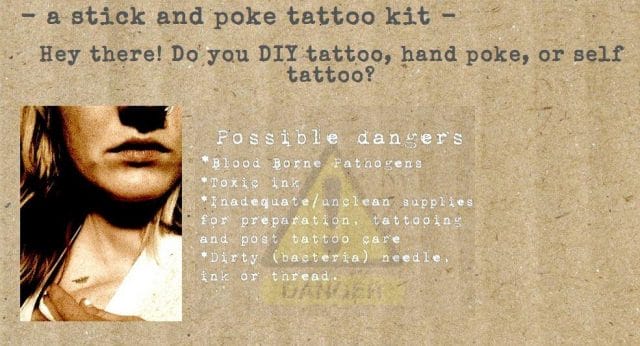
West knew from the beginning that her site would be unpopular among certain people. “My main worry when I started selling the kit was that I would get sued,” she tells us, “that’s why I incorporated.” She says that her business gets a steady stream of hate mail, mostly from professional tattoo artists. “West” is actually a pseudonym she invented, worried the parents of her students would find out about her double life and accuse her of corrupting the youth. West’s critics think that the kit makes home tattooing more accessible, and seem safer than it actually is — they say DIY tattoos are always dangerous irresponsible.
West counters that tattooing isn’t nearly as complicated as the industry makes it out to be: “It’s not dentistry, tattoo artists are not doctors, they’re putting ink in someone’s skin and it’s not that hard.” She says that without her kit, many people would be taking even bigger risks and tattooing with worse materials.
“You can’t throw a rock in a middle school around here without hitting a stick and poke tattoo,” West says. “All of these materials are really easy to get, and if you sue me you’re a total asshole and an idiot.”
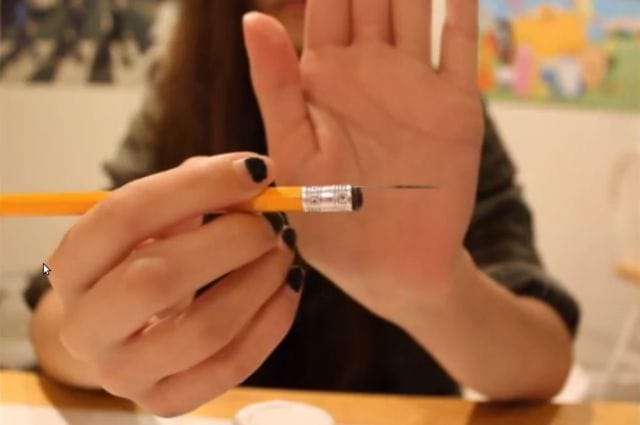
While outsiders to DIY tattoo culture see West as a dangerous iconoclast, insiders see her as kind of a square. “It’s kind of hard to be badass while doing it safely,” she explains. Her site has so many caveats that its tone verges on nagging. She is, after all, a school teacher. She strongly advises against stick and poking while intoxicated, and doubts many people do it successfully — unlike tattooing with a machine, with stick and poke you have to concentrate on every dot, which she says does not sound like a fun drunk activity. And she has a policy against selling her kit to minors, and does her best to enforce it.
“To the kiddos,” she writes on her business’s Facebook page, “wait until you’ve reined in your hormone habit before bodymoding.” This advice might be inspired by personal experience: West admits that she dislikes her first tattoo, which she got to impress a romantic interest (it’s a professionally-done line drawing of a lamp.)
Unglamorous as her site is, it’s doing well. Two stores in San Francisco stock her kit, but most of her sales are online. Although she makes most of her income teaching Elementary School Science, she says makes enough money from kit sales to pay her rent. She adds that her lifestyle is modest, but even so, West lives in the San Francisco Bay Area, one of the most expensive places to live in the country.
In the past few months, West says her business has “really blown up.”
Many outlets that reported on the DIY tattoo trend in the past year felt obligated to link to a means of responsibly self-tattooing — “Most of the mainstream media coverage of my kit has been, ‘What’s this? Might be dangerous! Back to commercial.’” — and it seems that West was the only game in town. CBS News flew her down to LA for an interview when they did a segment on DIY tattooing. In the lead-up to Christmas, West said she was selling four or five kits (which range from $20-$40) a day.
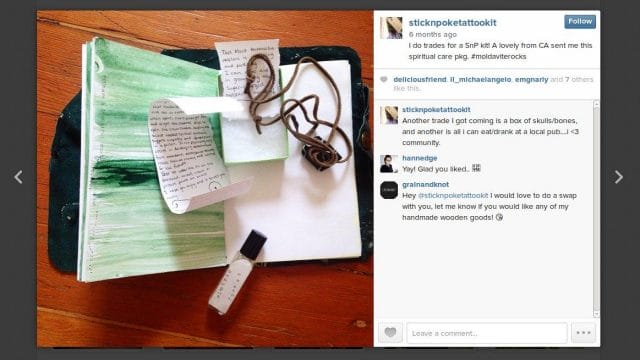
Hardly a ruthless businesswoman, West will sometimes trade her kit for art instead of cash
Despite the recent growth in business, West sees her kit more as a public service than a moneymaker. When somebody wants her kit and can’t afford it, she asks if they have anything they’d like to trade. This holiday season, she even threw a charity fundraiser: for ten days, she donated 100% of her profits to organizations within the Black Lives Matter movement.
She says she will change the product and website in the service of her mission to promote hygienic practices in stick and poke tattooing, but not to expand her business and make more money. “My dad says, ‘Oh, you should start selling other tattoo stuff,’” West says. “I might make more money that way, but I don’t care about other tattoo stuff. I don’t want to sell henna.”
All West seems to care about is making DIY tattoo culture safer and more responsible, one poke at a time.
If you enjoyed this post, you’ll like our book → Hipster Business Models.
This post was written by Rosie Cima; you can follow her on Twitter here. To get occasional notifications when we write blog posts, please sign up for our email list



